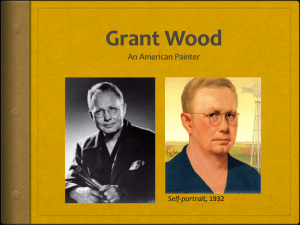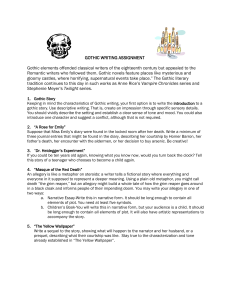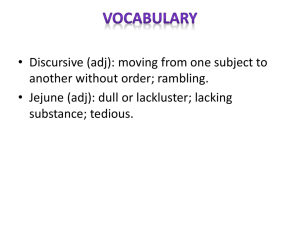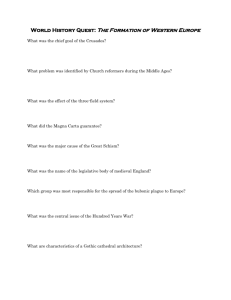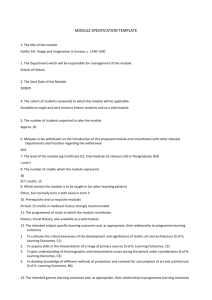Lesson Plan Grant Wood and American Gothic Parody
advertisement
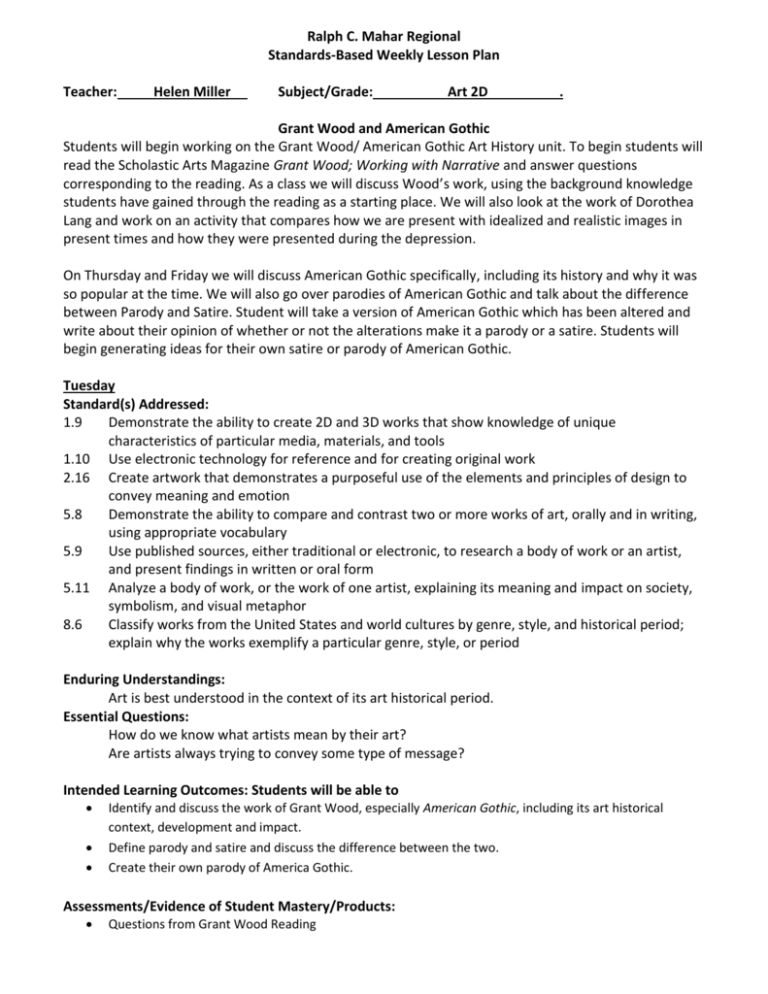
Ralph C. Mahar Regional Standards-Based Weekly Lesson Plan Teacher: Helen Miller Subject/Grade: Art 2D . Grant Wood and American Gothic Students will begin working on the Grant Wood/ American Gothic Art History unit. To begin students will read the Scholastic Arts Magazine Grant Wood; Working with Narrative and answer questions corresponding to the reading. As a class we will discuss Wood’s work, using the background knowledge students have gained through the reading as a starting place. We will also look at the work of Dorothea Lang and work on an activity that compares how we are present with idealized and realistic images in present times and how they were presented during the depression. On Thursday and Friday we will discuss American Gothic specifically, including its history and why it was so popular at the time. We will also go over parodies of American Gothic and talk about the difference between Parody and Satire. Student will take a version of American Gothic which has been altered and write about their opinion of whether or not the alterations make it a parody or a satire. Students will begin generating ideas for their own satire or parody of American Gothic. Tuesday Standard(s) Addressed: 1.9 Demonstrate the ability to create 2D and 3D works that show knowledge of unique characteristics of particular media, materials, and tools 1.10 Use electronic technology for reference and for creating original work 2.16 Create artwork that demonstrates a purposeful use of the elements and principles of design to convey meaning and emotion 5.8 Demonstrate the ability to compare and contrast two or more works of art, orally and in writing, using appropriate vocabulary 5.9 Use published sources, either traditional or electronic, to research a body of work or an artist, and present findings in written or oral form 5.11 Analyze a body of work, or the work of one artist, explaining its meaning and impact on society, symbolism, and visual metaphor 8.6 Classify works from the United States and world cultures by genre, style, and historical period; explain why the works exemplify a particular genre, style, or period Enduring Understandings: Art is best understood in the context of its art historical period. Essential Questions: How do we know what artists mean by their art? Are artists always trying to convey some type of message? Intended Learning Outcomes: Students will be able to Identify and discuss the work of Grant Wood, especially American Gothic, including its art historical context, development and impact. Define parody and satire and discuss the difference between the two. Create their own parody of America Gothic. Assessments/Evidence of Student Mastery/Products: Questions from Grant Wood Reading Evidence of understanding of idealism and realism in the pictures they choose for each example Student Learning Activities: Read the article on Grant wood for the art historical background and biographical information on grant wood Answer the questions which correspond to the reading View and discuss the work of Grant Wood Compare and contrast American Gothic and Migrant Mother Find one magazine image which depict an idealist view of something and one which depicts a nonidealistic view of something Resources (Materials/Texts/Visuals/Technology): Scholastic art magazine Questions Grant Wood PowerPoint Magazines Discussion of American Gothic and Parodies Standard(s) Addressed: 1.9 Demonstrate the ability to create 2D and 3D works that show knowledge of unique characteristics of particular media, materials, and tools 1.10 Use electronic technology for reference and for creating original work 2.16 Create artwork that demonstrates a purposeful use of the elements and principles of design to convey meaning and emotion 5.8 Demonstrate the ability to compare and contrast two or more works of art, orally and in writing, using appropriate vocabulary 5.9 Use published sources, either traditional or electronic, to research a body of work or an artist, and present findings in written or oral form 5.11 Analyze a body of work, or the work of one artist, explaining its meaning and impact on society, symbolism, and visual metaphor 8.6 Classify works from the United States and world cultures by genre, style, and historical period; explain why the works exemplify a particular genre, style, or period Enduring Understandings: Art is best understood in the context of its art historical period. Essential Questions: How do we know what artists mean by their art? Are artists always trying to convey some type of message? Intended Learning Outcomes: Students will be able to Identify and discuss the work of Grant Wood, especially American Gothic, including its art historical context, development and impact. Define parody and satire and discuss the difference between the two. Create their own parody of America Gothic. Assessments/Evidence of Student Mastery/Products: Participation during class discussion of American Gothic Parodies Student Learning Activities: View and discuss the different parodies of American Gothic Begin brainstorming for their own American Gothic Parody Resources (Materials/Texts/Visuals/Technology): American Gothic PowerPoint Paper Pencils Vocabulary Parody - an imitation of the style of a particular writer, artist, or genre with deliberate exaggeration for comic effect. Satire - the use of humor, irony, exaggeration, or ridicule to expose and criticize people's stupidity or vices, particularly in the context of contemporary politics and other topical issues Pastiche - an artistic work in a style that imitates that of another work, artist, or period, often with satirical intent Caricature - a picture, description, or imitation of a person or thing in which certain striking characteristics are exaggerated in order to create a comic or grotesque effect.

